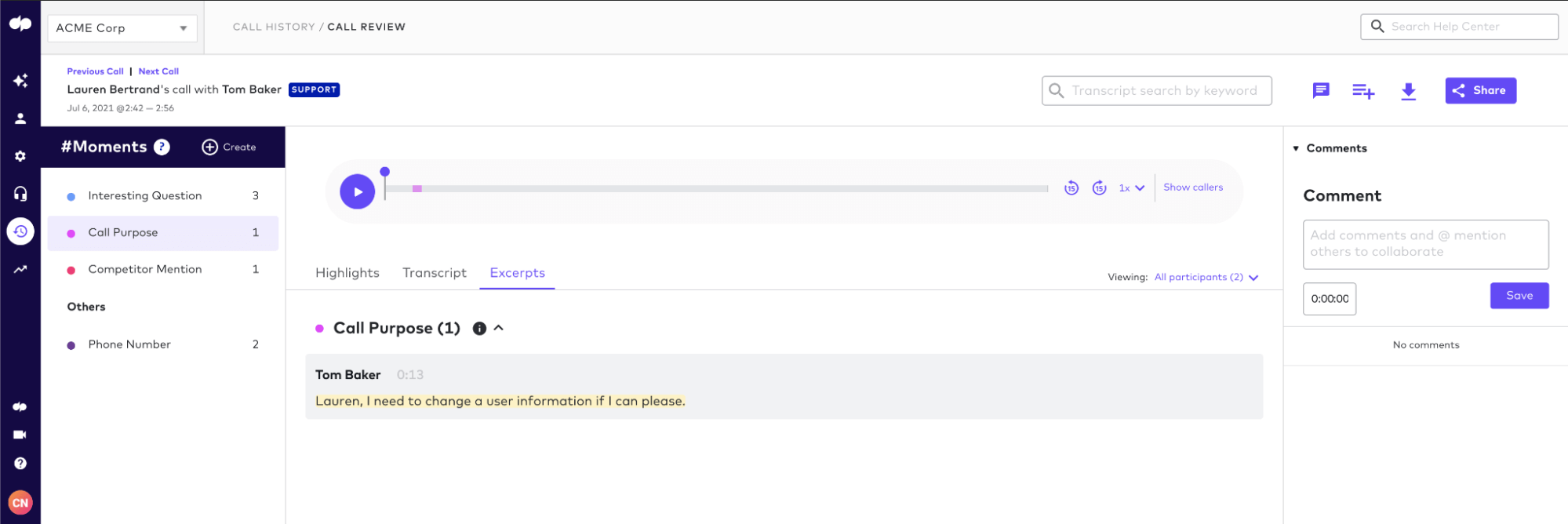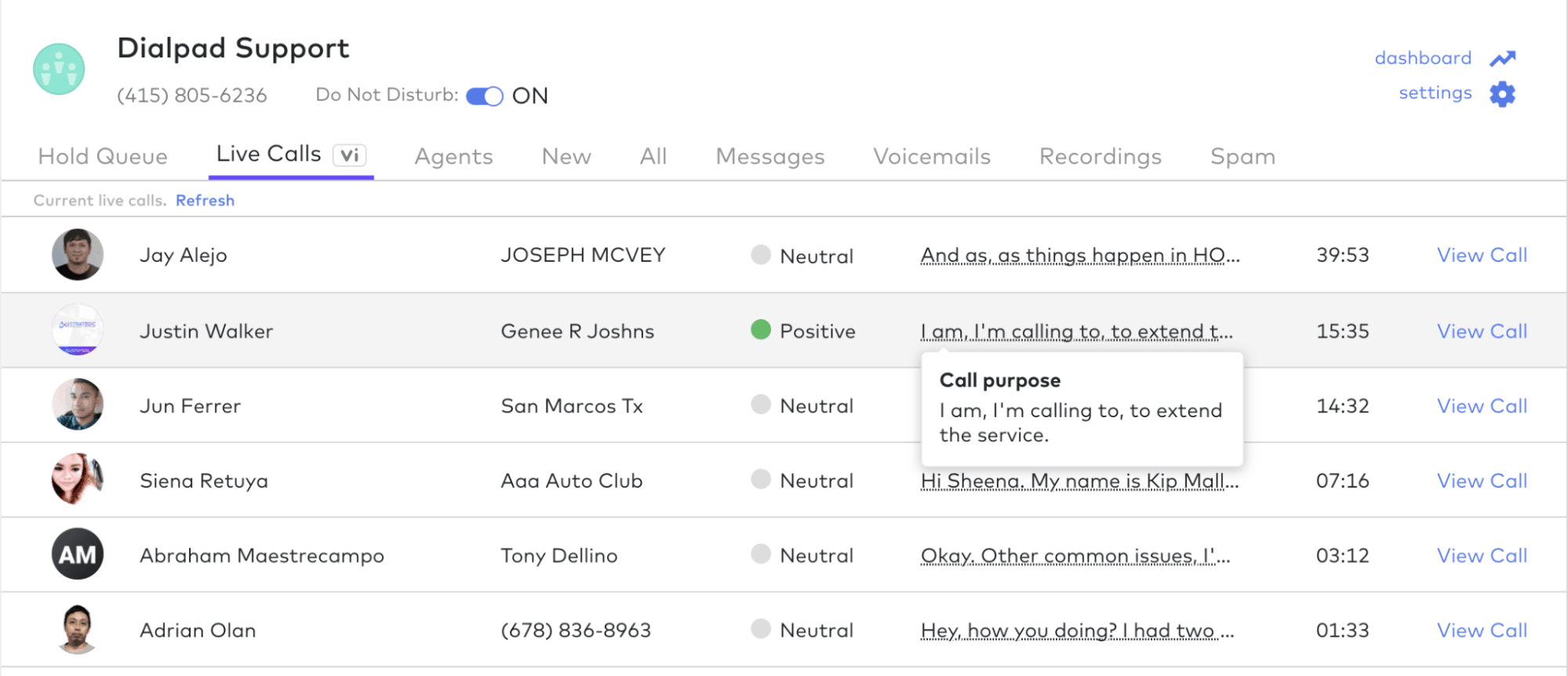Call Purpose Spotlight Series - Ch. 1: I just called to say I love you (and other reasons people call)

Customers call places of business for all sorts of reasons—to seek information, to report an issue with a product or service, to request for an action such as a cancellation or a refund to be initiated. Sometimes they even call to tell you how much they love you.
By the same token, business establishments call customers for all kinds of reasons—to sell their products, to collect information, to resolve issues, to ask for feedback. The Dialpad Ai team has been studying business conversations for years to understand common interaction patterns and extract actionable insights from these patterns.
Our hypothesis: it’s useful for businesses to know why customers and businesses typically call each other. So, we trained an AI model to do just that.
In this series, we’ll introduce you to Dialpad’s latest call purpose detection feature. This first chapter will outline a few ways that this feature can be helpful if you do a lot of your business on the phone.
Chapter 2 will outline why looking at the data is extremely important when designing AI models, and in Chapter 3, we’ll get into the weeds and show you how we (the Dialpad Ai team) built this feature.
The purpose of it all
We created a feature in Dialpad called the Call Purpose detection feature, which aims to detect the point in a call at which the purpose of the call is stated and extract that “Call Purpose” statement.
Some examples of Call Purpose statements:
I'm trying to open one of the programs on my computer and it's not opening so I’m hoping I can get some assistance with that.
I was just wanting to talk with you about the new map that we’re publishing of the city.
I was researching last night about student loan lawyers and I wanted to know if I could talk to someone before I decide if it's worth it for me to get one.
The way a speaker states their reason for calling, as well as the reason itself, sets the stage for the rest of the conversation and can dictate the call’s length, flow, content, tone and outcome.
Here’s how it looks:

Our customers have found the feature valuable for a variety of business needs...
7 ways to use call purpose detection for your business
1. Real-time monitoring of calls
A contact center manager can see a list of ongoing calls with agent name and call purpose and decide to monitor or intervene in certain calls based on a combination of the stated call purpose and other indicators, such as customer sentiment expressed, in the ongoing conversation:

2. More effective call taking
A contact center agent is able to pull up all previous interactions with a customer when needed, each of which is encapsulated by a concise Call Purpose statement. Having access to a neat history such as this has led to more efficient call taking and resolution.
Similarly, sales reps can hone in on the common characteristics of successful sales calls that converted prospects to customers by studying the structure of these calls. One significant component of call flow is when and how the reason for calling is stated.
Research has shown that the first few minutes of a conversation—the part that usually contains a call purpose—are a major predictor of whether the call will be converted to an action and could be addressed accordingly from the start of the call.1
3. Coaching
By tracking the most common reasons for which customers’ call, contact center managers can better coach agents on how to respond to different types of calls.
4. Learning customer pain points
Studying the issues that customers commonly call about helps teams find long-term solutions to address them.
5. Improving your contact center setup
Keeping track of the reasons for both incoming and outbound calls helps a manager decide if, when and how to transform their contact centers to address the ever changing needs of the business. This also helps them make decisions (such as whether there should be more agents with a certain profile or a whole new call center) in a more data driven way.
6. Finding “that” call
When you need to pull up a conversation transcript searching for a specific piece of information, a Call Purpose statement makes it easier to find.
7. General trends and anomaly detection
Keeping an eye on Call Purpose statements over a certain time period can be a good way for contact center managers to get a bird’s eye view of the main reasons for which customers are calling in. If there are any emerging trends or anomalies, they’ll likely pop up here first.
For instance, if after the launch of a new product line, there is a flurry of calls asking for a return or refund, this is useful information for a business to know and address.
🔜 Coming soon…
In Dialpad, you’ll be able to see these aggregates combined with other metrics such as estimated customer satisfaction, hold time, to yield highly informative insights. We’re still in the early stages of release for this feature, but it’ll be available to all our customers very soon!
Want to understand why your customers are calling?
If you’re already using Dialpad, take the Call Purpose feature for a test run and let us know what you think!
And if you’re looking for a business phone system or cloud contact center platform that gives you these types of insights, book a product tour to see how you could use Dialpad to understand your customer conversations better.
Don't miss Chapter 2 and Chapter 3 of the Call Purpose series to learn more about how we built this feature.
1Takeuchi et al. (2007) Takeuchi, H., Subramaniam, L. V., Nasukawa, T., & Roy, S. (2007, June). Automatic identification of important segments and expressions for mining of business-oriented conversations at contact centers. In Proceedings of the 2007 Joint Conference on Empirical Methods in Natural Language Processing and Computational Natural Language Learning (EMNLP-CoNLL) (pp. 458-467)


